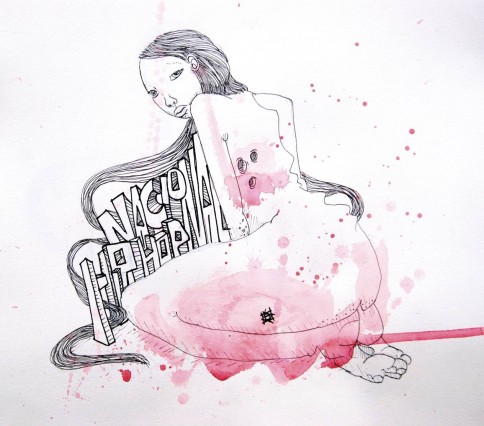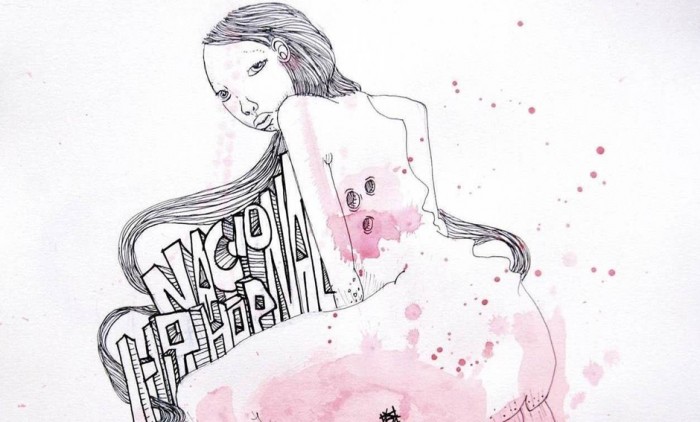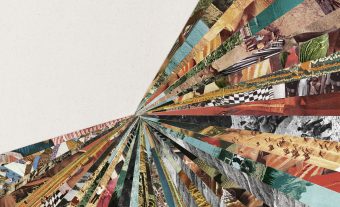This summer, eyes across the globe will be focused on Brazil when the 20th World Cup kicks off in São Paulo, although not necessarily for the right reasons. On one side, the corpulent corporate leech otherwise known as FIFA president Sepp Blatter has criticised Brazil for starting work on preparations “far too late”, with several stadiums still to be completed and five construction worker fatalities so far.
On the other side of the coin, a sizable proportion of the Brazilian population are pretty pissed off that the tournament is happening at all. Last year’s Confederations Cup, the traditional early curtain raiser for the main event, was marred by huge protests, sparked by anger over runaway spending on the event at the expense of essential public services. When Brazilian football legends like Romario call for more protests and even members of the current squad back the demonstrations, it seems likely that the tournament will create as many headlines on the front pages as the back ones.
Which is going to make life a lot harder for television producers, travel agents and tourist boards this year, all of whom were no doubt relying on being able to portray Brazil as a sun-kissed idyll, where half-naked models play football on the beach from noon till night while humming ‘The Girl From Ipanema’, only stopping to down the occasional Caipirinha. Instead, we’ll be presented with a more realistic picture – an incredible, fascinating and diverse country riddled with contradictions (and, often, corruption).
Anyone looking for an insightful potted history could do worse than buying a copy of Peter Robb’s book A Death in Brazil, which details how cut-throat politics, unreliable resources, successive colonisations and (sometimes violent) cultural clashes have combined to create a truly unique nation, almost overwhelming in its myriad idiosyncrasies. Yet while Robb revels in bringing Brazil’s political, sexual, racial and gastronomic history to life (while the sporting side barely needs expanding on), his work is a little light on another crucial facet of the country’s identity – music.
Perhaps thanks to its multifarious make-up (beyond the obvious Portuguese connection, the largest Italian and Japanese populations outside of their own borders can be found within Brazil), not many nations can claim to have created so many musical genres. From Samba and Sertanejo to Bossa Nova and Baile Funk, the nation’s heartbeat rocks to so many different pulses it’s a wonder it doesn’t keel over. Yet despite this rich history, it turns out the best music emerging from Brazil right now actually has its origins on the northern side of the American continent.
Having exploded out of the afro-dominated slums of São Paulo in the ’80s, the quality of Brazilian hip-hop is arguably at its peak right now, and interestingly it’s women rather than men who are leading the pack. Thanks to our friends at Brazilian music and street art agency Cult Cartel (who facilitated our interview with graffiti artist Alex Senna last year), we’ve been exposed to a raft of incredible Brazilian music over the last year, from masterful psychedelic relics like Pedro Santos’ Krishnanda LP to the US-born, Rio-based ‘transnational bass’ stylings of the irrepressible Maga Bo. Yet it’s been the diamond-cut rhythms and razor-sharp rhymes from ‘rapeiros’ like Karol Conka, Amanda NegraSim and Lurdez da Luz that have really blown us away.
Hailing from the southern city of Curitiba, Conka’s debut album Batuk Freak (released last Spring) is a perfect representation of this exciting new breed of Brazilian beats. Whereas once the genre could’ve been crudely summed up as simply Portuguese lyrics over American beats, ‘Batuk Freak’ is the most wholly realised example yet of what makes Brazilian hip-hop so special right now. Melting down an intoxicating selection of traditional rhythms and instruments and pouring them into an earth-tremblingly bassy Trap mould, the fact that non-Portuguese speakers like me haven’t got a clue what the lyrics mean doesn’t stop her flow from feeling fluently righteous.
After winning a school rap contest aged 16, Conka took to music like the proverbial duck to water, although making significantly more waves while doing so than your average White-Faced Whistler. “I don’t know exactly when I fell in love with music,” she admits, “[but] I felt very at ease when I started composing. It was the fact that I could create melodies over instrumentals and beats that made me very happy. Then I saw a CD with the face of a beautiful black girl [Lauryn Hill, then of The Fugees]. I bought it and she began to be an inspiration to me”.
While Brazil is one of the most racially diverse countries in the world (43% of respondents to the most recent census described themselves as “multiracial”), that doesn’t necessarily mean it’s any more equal – faces get noticeably paler the further you travel through the corridors of power. Yet while Afro-Brazilians may still struggle to have their voices heard politically, their cultural contribution runs deep; particularly when it comes to music. Some have attributed this to the fact that Brazilian slave owners, in comparison to those in other nations, didn’t confiscate drums from their African slaves, helping to forge the nation’s signature rhythms.
Conka concurs, highlighting traditional Brazilian music as a huge inspiration, alongside foreign idols Bob Marley and the aforementioned Hill, and newer styles like Trap. “Brazilian music is super influenced by African rhythms. Our folklore is very rich and inspiring. What touches me are the beats, I like them well-charged and warm. Samba, jongo, repente and maracatu are present in my work, [while] Trap attracts me because of the dirty and aggressive beats. I’d love to collaborate with TNGHT“.
It’s this exotic, magpie-esque sound that makes her music so attractive to foreign ears too, with Conka pleased to report that she’s “been receiving nice recognition of my work from Europe”. This includes a recent collaboration with Portuguese dance act Buraka Som Sistema (below) that’s racked up over two million Youtube views since being featured on an advert for adidas’ Samba Collection.
Her popularity was also boosted by a smart social media powered promotional campaign, which saw her give away free album downloads in exchange for retweets and Facebook shares. “I think that music has to be accessible to all,” she explains. “Making the album available for free really helped to publicise the work. As netizens downloaded ‘Batuk Freak’, it automatically divulged the link on their social networks, sparking interest from other people. In a week, downloads passed 22,000 on Vice’s website. I have no doubt it worked”.
Perhaps it’s thanks to this success that Conka doesn’t see her gender as being any obstacle to her progression in the Brazilian rap game. “No, I don’t think so. We have great female names in Brazilian music that serve an examples, Ivete Sangalo, Elis Regina, Beth Carvalho, Cassia Eller, Céu, Alcione, Rita Lee, Pitty, Martinália, and so on”. Yet that opinion isn’t one that’s shared by all of her female contemporaries, not least the fiercely political São Paulo rapper Amanda NegraSim.
“It’s difficult for a woman to conquer her own space independently in any position she chooses,” NegraSim insists. “With an ingrained sexism that’s part of our social values, women find difficulty in all areas, especially in the job market. The profession of a singer is the same, the difficulty comes from a lack of people who invest in your career. I say this because the work involves many hours of dedication, constant rehearsal; it’s like a jewel that needs to be polished. How to develop the richness of the art in someone who needs to get money to survive? Many artists end up leaving their gift aside because of life’s demands – they start being mothers, have a family… and as I said, the good result, development, comes from the constant dedication”.
NegraSim’s music, like Conka’s, stems from being surrounded by various musical styles at a young age. “I had the fortune to be born into a family rich in culture and knowledgeable of local traditions ranging from northern to southeastern Brazil. We heard all kinds of music, including samba, soul, funk, swing, classical music and Brazilian music, and this whole experience has expanded my musical taste”.
As well as attending African religious rituals with her mother, NegraSim’s grandmother also took her to singing lessons at the local evangelical church. “In this way,” she explains, “I identified with some divas of Brazilian music, such as Ivone Lara, Clara Nunes, Elza Soares and Elis Regina, who sing with their soul”. Strong women with a distinctive sound? When you hear NegraSim’s strident, soulful music, that makes perfect sense, with the rapper also nominating Tina Turner as her biggest non-Brazilian inspiration, “who beyond her musical talent, brings a very beautiful story, a real fighter”.
NegraSim has grown proficient at using several local weapons when fighting her own musical battle. “I love the percussion instruments, which are the basis of the Brazilian samba. Cordel literature also assists in the production of poetry. I’m an artist, and Brazil is a country very rich in sonority and differences, so I try to include in everything I do a little bit of my experiences”.
When it comes to hip-hop, those experiences were originally gained as an observer rather than a participant; NegraSim was a music journalist for a regional newspaper before switching to writing bars rather than articles, something she says has influenced her attitude onstage, “because I know my audience and I know what I want to say”. For the benefit of monolingual morons like myself, she then spells out exactly what that is: “[My lyrics] talk of love, and the struggles of the day-to-day that include housing and people’s rights”.
She has the political credentials to back up her verses too. NegraSim is an active member of the MSTC [Downtown Homeless Movement], a huge urban squatting project (their biggest building houses more than 300 families, and is documented in the short Vincent Moon film below, which she presents), having been introduced to the organisation by fellow MC Lua Rodrigues. “After being invited by her to attend a meeting, I got interested and wanted to know more about the history, the struggle. So I decided to jump in, and lived in one of the occupied buildings, and there I was coordinating cultural activities with children and youth. I also learned that you can be happy with little. The little must be enough for you to get around, eat and smile; the daily fight for survival has to part of your happiness. After all who does not fight is dead!”
Yet while NegraSim aims to bring attention to political problems through her work, she refuses to badmouth rappers who spit less lofty lyrics. “I believe that hip-hop is a way to break free, and rap is a form to freely express your rhymes and feelings. The work depends a lot on what sort of reality the artist experiences, what they felt at the time. I was saved by the words of rap, so it’s hard to criticize. Some people do not like to talk about crime, but… every type of rap has a word, a feeling held within its core. Rap freed my soul, so today I’m Amanda Negrasim, and I will carry all this culture with me on my road”.
Another MC travelling down that road is Lurdez da Luz, whose stage name translates as Lourdes of Light and is derived from a light railway station in the São Paulo neighbourhood where she grew up. Like NegraSim, her introduction into music was maternal (“I believe it was my mother’s voice singing Brazilian music for me to sleep”), although it was later that her passion fully bloomed: “I started going crazy with all the different music at the most diverse parties. I’d record every track played on the radio on cassettes, till I discovered some second-hand record shops close to mine and started buying vinyl”.
Beyond the record racks, being born in a country where regions can be as culturally different as bordering nations in Europe meant da Luz has never been short of inspiration. “I never lived in another country” she explains. “I have family in Bahia, so I feel very close to this place due to some intimacy and cultural identification, which is already a Brazil different from the Brazil of my daily life in São Paulo. But the Brazilian elements as well as the non-Brazilian elements are incorporated [in my music]. Samba is the basis of everything I do in one way or another, either in a lyric, a rhythmic cell, a melody in the chorus, a cavaco (brazilian ukelele), a berimbau, it’s all there and it is all ours”.
Describing herself as “a poet of the streets”, da Luz sides with NegraSim in the debate over whether gender is a hindrance in the music industry (“not only talking from my own experience, but all I see backstage and in historical analysis and statistics”). And while rapping with Mamelo Sound System from the late ’90s onwards allowed her to share stages with US hip-hop legends like Jurassic 5, De La Soul and The Pharcyde, those she’s proudest to have collaborated with come from closer to home: “For me, being able to play with really good musicians, singers and MCs close to my reality makes me very happy, like Kiko Dinucci, Creole, Arnaldo Antunes, Marku Ribas and Alafia”.
Like Conka and NegraSim, a lack of industry support means that her relatively lengthy career doesn’t have a corresponding slew of official releases to show for it (although she does have a full album planned for this year); independent releases have been the standard for all three. Building up hype and respect is one thing, but transforming it into material success is a difficult and labourious process – Brazil may have a population over three times the size of Britain’s, but the gulf in disposable income means the country’s music sales lag behind, with entertainment piracy percentages estimated to be more than double those in the UK.
Even Conka, the most high-profile of the three, has had to struggle hard to gain that recognition, with years of hard work finally culminating in a MultiShow trophy (Brazilian national music award) for Best Artist in 2013. “It’s a long road,” she admits, “anyone who goes independent knows how difficult it is to reach the masses. I had to have a lot of patience to accomplish the dream of releasing an album. My effort was recognized and I was rewarded, but I find myself at the beginning of a new phase – nothing comes easy or free, it takes some sweat to make things happen. I was happy and surprised with the award. Now is time to carry on with both feet in the ground and take responsibility”.
After suffering generations of corruption, inequality and authoritarianism, it’s an attitude that seems to be chiming with popular Brazilian opinion. Whereas once football and music were used to mask deficiencies in wider society, now Brazilians are taking advantage of their sporting and cultural legacies and using them to highlight political discrepancies. All the artists we spoke to support the protests and, encouragingly, there is a note of optimism amongst the anger that all three feel towards the government. “It’s shameful,” states Conka bluntly, “but we are in a time of change. A lot will still happen with the awakening of the population”.
Lurdez da Luz expands further: “It’s better than before, but still sucks in terms of social welfare and income distribution. We still are a colony, and an underdeveloped country. If you saw that movie ‘City of God’, that shows Rio in the ’70s and is pretty much what still happens on the periphery of large cities today; with smartphones and motorbikes but lacking everything else: health, education, sanitation. And there’s still plenty of violence. But we are in a time where dissatisfaction is taking the shape of action, and everyone is willing to transform themselves, the environment around them, the whole world.”
However, the idea of an awakening, whether national or as part of a global shift (the Confederations Cup uprisings were dubbed ‘The Brazilian Spring’ in some quarters), is contradicted by NegraSim’s assessment. “Perhaps the image that people have of Brazil now is that people have woken up to all the excesses of the politicians, given the recent events that reverberated internationally,” she begins, “but no, we from organised movements never slept, and have always been active in the fight for our rights. The situation is exploitation, which comes from the time of colonisation. It’s all wrong! Some politicians earn exorbitant salaries while the real workers, who actually contribute to our society, earn barely enough to eat. I think the government should pay more attention to the people, and the people should keep on fighting for their rights. Rap comes with this goal: it is a way to fight capitalism”.
As a call to arms, it’s a far cry from Kanye West comparing himself to Malcolm X before choosing to sample ‘Strange Fruit’, a song depicting racist lynchings, to soundtrack a misogynistic rant about alimony (see Dorian Lynskey’s article on the politics of Yeezus for a lengthier assessment). Karol Conka, Lurdez da Luz and Amanda NegraSim don’t have to paint themselves as leaders of the people or the voice of the streets; they are the people, and their voices are that much more credible because they’re still on the streets and in the squats, not riding in limos and satisfying their egos with empty posturing.
Once a pale shadow of its north American cousin, Brazilian hip-hop is now, musically and socially, threatening to overtake it. FIFA may be praying for a successful world cup this summer, but even if you can’t bear to watch a carnival of unfinished stadiums, political unrest and police crackdowns, make sure you keep your ears open – artists like Karol Conka and her peers can match with a mic whatever Neymar can do with a football.

Other Brazilian music worth checking out, according to the artists themselves:
Karol Conka: Here in Curitiba there are different genres, but I’ll talk about the scene I live in, which is rap. I recommend Karol de Souza, Hurakan, Savave, Nairobi, while in beat production there are Laudz, Cabes, and Dario, among others. In the alternative scene, I like the rock of Banda Gentileza.
Lurdez da Luz: For me we are always living in a musically rich moment. I recommend the bands Alafia and Bemba Trio as well as Russo Passapusso’s solo career, singer Luciana Oliveira, Curumim, Garotas Suecas, Don L, Raphão Alaafin and Larissa Luz, among others …
Amanda NegraSim: The Hip Hop culture, which involves five elements (MCing, DJing, Breaking, Graffiti and Knowledge) has been growing. I believe that this growth comes primarily with development of the fifth element, knowledge. Artists today, knowing their roots, explore a more diverse musicality and positive trends of Brazilian culture, which results in very rich work, sound and production wise. I recommend Z’África Brazil, Afavel, Yzalú, Lua Rodrigues, and also the Poetry Soiree, fundamental for the artist to expand their writing ability.
Words: Kier Wiater Carnihan
Illustration: Magrela
Translation: Alex Canonico






Follow us
Follow us on Facebook Follow us on Twitter Follow us on Google+ Subscribe our newsletter Add us to your feeds